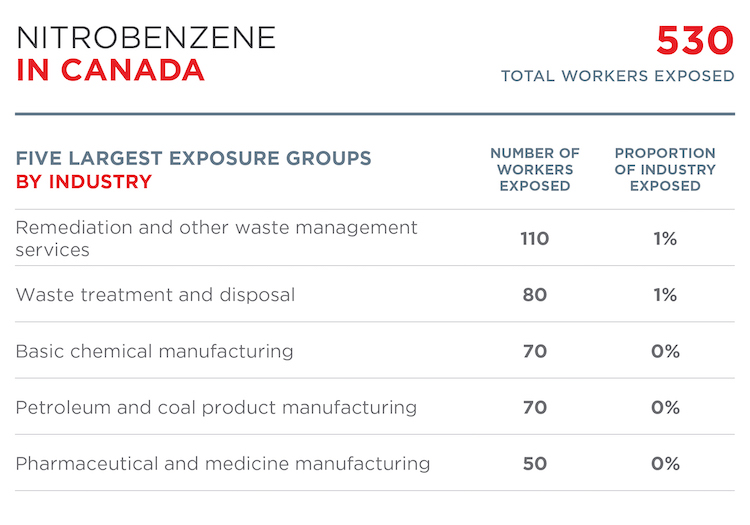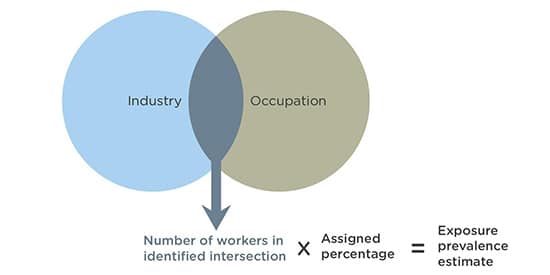Nitrobenzene Occupational Exposures
Nitrobenzene Occupational Exposures
Overview
The most important routes of occupational exposure to nitrobenzene include inhaling vapours and dermal contact with vapours or liquid.[1]
CAREX Canada estimates that approximately 530 Canadians are exposed to nitrobenzene in their workplaces. The largest industrial groups exposed to nitrobenzene are remediation and other waste management services, waste treatment and disposal, and basic chemical manufacturing.
READ MORE...
The largest occupational groups exposed to nitrobenzene are water and waste treatment plant operators, chemists, central control and process operators in petroleum, gas and chemical processing, and chemical plant machine operators. Other potentially exposed occupations include equipment maintenance or janitorial staff working in chemical manufacturing or laboratories that use nitrobenzene.[2]
Engineering controls (activated charcoal filters) and closed systems minimize releases of nitrobenzene during production.[1]
Prevalence Estimate
Results show that approximately 530 Canadians are exposed to nitrobenzene in their workplaces; 76% of these workers are male. Industries with the greatest numbers of exposed workers are remediation and other waste management services, waste treatment and disposal, and basic chemical manufacturing.
When exposure is examined by occupation, the largest exposed groups are water and waste treatment plant operators (100 workers exposed), chemists (100 workers exposed), central control and process operators in petroleum, gas and chemical processing (70 workers exposed), and chemical plant machine operators (70 workers exposed).
The number of workers exposed to nitrobenzene remained approximately the same from 2006 to 2016 (a 2% increase).
Workers exposed to nitrobenzene by industry in 2016

Workers exposed to nitrobenzene by region
Click the second tab to view total number of workers exposed.
* = < 50 workers
Methods and Data
Our Occupational Approach page outlines the general approach used to calculate prevalence and exposure level estimates for workplace exposures.
Data Sources
Data used in developing the occupational estimates for nitrobenzene were collected from several sources:
- Canadian and US scientific peer reviewed publications that addressed nitrobenzene exposure in Canada and the United States.
- Grey literature including technical reports from governments and international bodies.
Prevalence Estimate Method
CAREX defines exposure to nitrobenzene as inhalation exposure at work above levels encountered in the general environment.
To determine the number of workers potentially exposed to nitrobenzene at work, CAREX occupational exposure experts used methods previously established in other peer-reviewed CAREX projects in Europe. A series of steps were taken to assign exposure proportions to occupations and industries at risk of exposure to nitrobenzene.

- Occupations and industries at risk of possible exposure to nitrobenzene were identified using any combination of data sources described above.
- The total number of workers in each identified occupation and industry intersection was obtained from Statistics Canada 2016 census data.
- A percentage of workers exposed was assigned to that occupation and industry intersection. Percentages were determined by consultation with existing evidence in the data sources, previously established methods from the Europe CAREX estimates and the expert judgement of CAREX occupational hygienists.
- The number of workers in the identified group is multiplied by the assigned percentage to calculate the prevalence estimate of workers exposed to nitrobenzene.
Sources
Subscribe to our newsletters
The CAREX Canada team offers two regular newsletters: the biannual e-Bulletin summarizing information on upcoming webinars, new publications, and updates to estimates and tools; and the monthly Carcinogens in the News, a digest of media articles, government reports, and academic literature related to the carcinogens we’ve classified as important for surveillance in Canada. Sign up for one or both of these newsletters below.
CAREX Canada
School of Population and Public Health
University of British Columbia
Vancouver Campus
370A - 2206 East Mall
Vancouver, BC V6T 1Z3
CANADA
As a national organization, our work extends across borders into many Indigenous lands throughout Canada. We gratefully acknowledge that our host institution, the University of British Columbia Point Grey campus, is located on the traditional, ancestral and unceded territories of the xʷməθkʷəy̓əm (Musqueam) people.



